1961-1975: To New Heights
By Air Force Flight Test Center History Office, Dr. James Young, Chief Historian
Now, a full colonel, Yeager returned to Edwards as deputy director of flight test in 1961. The following year he took over as commander of the new USAF Aerospace Research Pilot School (ARPS), where he presided over the development of a first-of-its-kind institution designed to prepare U.S. military test pilots for spaceflight. Building on the existing test pilot school curriculum, ARPS offered rigorous, graduate-level training in subjects such as astrophysics and orbital mechanics, and it employed a one-of-a-kind flight simulator and other state-of-the-art training systems that prepared students to master an entirely new frontier beyond the atmosphere. The school was swamped with applicants and only the best and brightest—1% by Yeager’s estimate—were granted admission.
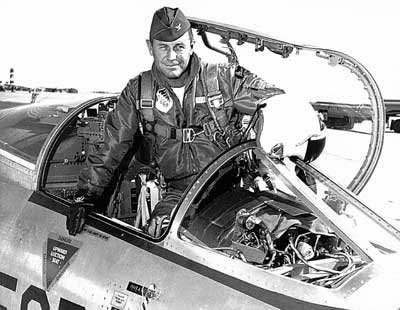
Yeager in the cockpit of an F-104 Starfighter, one of the curriculum aircraft employed by the USAF Aerospace Research Pilot School during the 1960s.
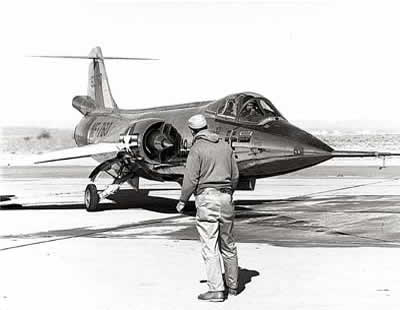
Yeager in the cockpit of his NF-104 Starfighter prior to a flight at Edwards AFB, 1963.
The excellence of the training provided during the school’s ten-years of operation (1961-71) can be surmised by the fact that 37 graduates were selected for the U.S. space program and 26 earned astronaut’s wings by flying in the Gemini, Apollo and Space Shuttle programs. Although Yeager never got a chance to fly in space, in his role as mentor to a whole generation of spaceflight pioneers, he made an important contribution to its exploration. It remains one of his proudest achievements.
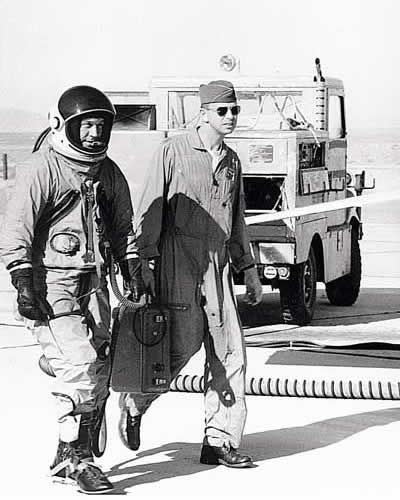
All suited up: Yeager approaches the NF-104 Starfighter prior to his flights on 10 December 1963.

The NF-104 Starfighter going up.
The NF-104 was a training system proposed by ARPS curriculum. Modified with a 6,000-lb thrust rocket booster and reaction controls, it was designed to permit students to zoom up above 100,000 feet in a ballistic arc and gain experience operating in a zero-G environment. Yeager made a pair of flights in one of the airplanes on 10 December 1963. All went well during the first, as he climbed above 108,000 feet. As he went over the top at 104,000 feet during the second, however, the NF-104 pitched up, fell off flat and went into a spin. He struggled to recover the airplane through 13 flat spins as it plummeted more than 90,000 feet before he finally punched out. Though seriously injured, he fully recovered and returned to flight status just six weeks later.

Among the ARPS Class III graduates (1963), Capt. Mike Collins (front right) went on to Gemini X and Apollo 11 (first lunar landing mission) while Capt Joe Engle (standing at right) became the first—and so far only—person to fly into space in two different winged vehicles, the X-15 and the Space Shuttle.
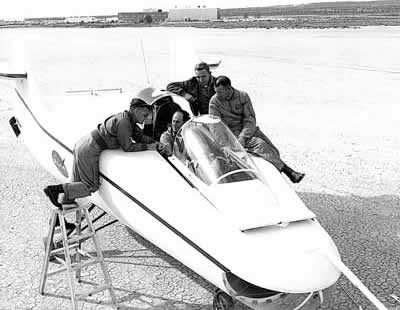
December 3, 1963: Yeager getting M2-F1 Lifting Body cockpit check-out from NASA’s Milt Thompson while Bruce Peterson and Don Mallick look on.
Yeager got to fly almost everything on the flight line and, because he was held in such high regard, he was frequently asked to provide assessments of new combat aircraft and concept demonstrators. At NASA’s request, on 3 December 1963, he became the first USAF pilot (and only 3rd pilot, overall) to fly a lifting body as he evaluated the M2-F1 “Flying Bathtub”.

Yeager briefing Vice President Hubert H. Humphrey on the operation of the T-27 spaceflight simulator, a first-of-its-kind system that provided ARPS students with hands-on training in launch, orbital rendezvous, docking, and reentry operations.

Col. Chuck Yeager with Brig. Gen. Pete Everest, and Col. Bud Anderson on the ramp at Kadena Air Base, Okinawa, in 1967. All three were fighter pilots in World War II and test pilots at Edwards in the 1960s. When this meeting occurred, Everest was Chief of Safety for the USAF, Yeager commanded the 405th Fighter Wing, and Anderson commanded the 18th Tactical Fighter Group.
Combat has always been the ultimate flying experience for Chuck Yeager and he finally returned to it in 1966 when he took command of the 405th Fighter Wing. With his headquarters at Clark Air Base in the Philippines, Yeager commanded five squadrons and detachments scattered across Southeast Asia: two tactical bomber squadrons flying B-57s out of Clark and Phan Rang Air Base in South Vietnam; a squadron of F-100 fighter-bombers based in Taiwan; a pair of F-102 air defense squadrons flying out of Da Nang, South Vietnam; and detached units flying a variety of aircraft, including F-4s out of places like Da Nang and Udorn and Bankok, Thailand.
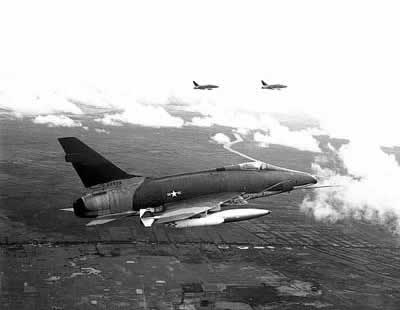
Another of Yeager’s squadrons flew F-100 fighter-bombers similar to these en route to a target area in South Vietnam, 1966.

A pair of F-102s from one of Yeager’s squadrons flying over Thailand, 1966.
Yeager made an effort to visit and fly with each of these units once every 10-12 days. Flying primarily close air support and interdiction missions in a B-57, he added 127 flights and 414 hours to his combat record.

Yeager also commanded detachments at several locations. In this photo, an F-4C is landing at Da Nang Air Base following a combat mission, March 1967.

A B-57 from one of Yeager’s squadrons flying over Phan Rang Air Base, South Vietnam. Yeager flew most of his combat missions in one of these light bombers.
In March 1968, he took over command of the 4th Tactical Fighter Wing while it was deployed to Kunsan AB, Korea, in response to the Pueblo crisis (seizure of a U.S. military vessel by N. Korea). It remained in Korea through June 1968 when Yeager, once again, led it on a perfect redeployment back to its home base at Seymour Johnson AFB, NC. Under his command, the 4th achieved its first “Outstanding Unit” citation . . . and the one-time enlisted crew chief was promoted to the rank of Brigadier General.

Yeager with Col. Jack W. Hayes just after change-of-command ceremony for the 4th Tactical Fighter Wing at Kunsan AB, Korea, 23 March 1968.
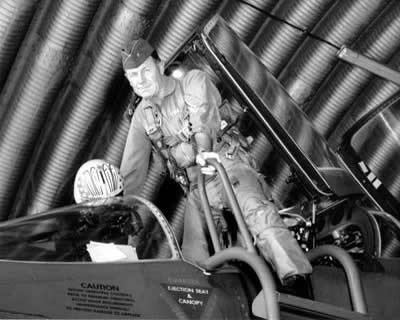
A new one-star: Brig. Gen. Chuck Yeager shortly after he arrived in Germany to take over duties as vice commander of the Seventeenth Air Force.
Last Active Duty Flight
In July 1969, Brigadier General Yeager returned to Europe as vice commander of the Seventeenth Air Force where he worked closely with the West Germans in organizing joint exercises and training. In January 1971, he moved into an entirely different type of assignment when he became U.S. Defense Representative to Pakistan at a time when tensions were high in that region of the world. He returned stateside in March of 1973 to take over as USAF Director of Aerospace Safety at Norton AFB, CA.
On 25 February 1975, he returned to Edwards AFB for his last official active duty flight in an F-4C Phantom II. When he climbed out of the cockpit that day, he had accumulated a total of 10,131.6 hours in some 361 different types and models of military aircraft during an extraordinary flying career. Three days later, on 28 February 1975, General Jimmy Doolittle, Maj Gen Albert Boyd and Jackie Cochran were among the dignitaries in attendance as he completed his active duty service during ceremonies at Norton AFB.
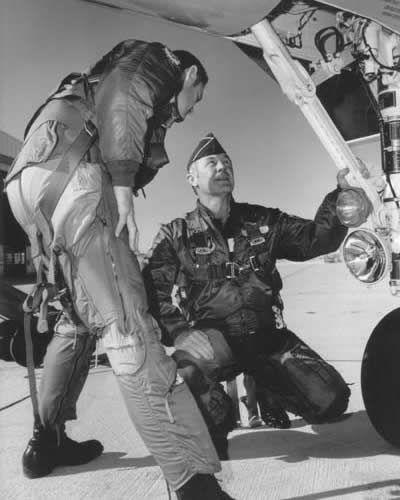
As USAF Director of Aerospace Safety, he logged his first flight in the new F-15 Eagle at Edwards AFB on 6 March 1974.
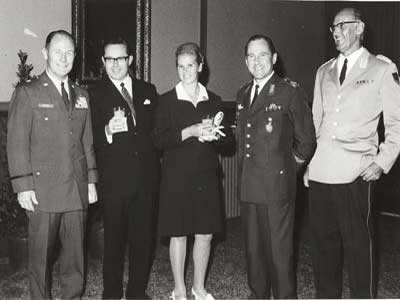
A pair of aces: Yeager and famed World War II German ace Gunther Rall (2nd from right; 275 combat victories) during a meeting at Ramstein Air Base, West Germany, 1970.
